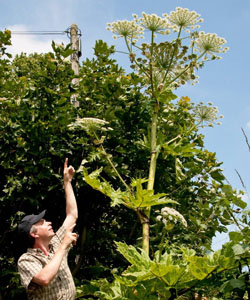
Giant hogweed is a fast-growing invasive plant. It mainly grows next to water, in damp meadows or on derelict land.
It grows exclusively by seeds, which can be planted deliberately or carried by wind or water.
It can cause harm to humans and animals and although not native to the UK, it’s now widespread.
WARNING! Don’t touch giant hogweed as the sap can cause painful burns and make your skin sensitive to strong sunlight. If you’re affected by it, wash the area with soapy water and contact your doctor for advice.
How do I identify it?
Giant Hogweed is easy to identify when fully grown by height, size of leaves and size of flowers. However, when not fully grown it can be easily confused with common hogweed and cow parsley. When identifying Giant hogweed, look out for:
- White flower blooms
- Thick purple-reddish stem with many stiff white hairs
- A height of up to 5m (15') tall when fully grown.
What you should know
- You should avoid contact with the plant as the sap can cause irritation to the skin
- It is the landowner's responsibility to control these plants. You must not allow it to spread to other people's land or property. However, you do not have to remove it from your own land
- If you see Giant hogweed on private land e.g. a neighbouring property, a construction site, agricultural fields, speak to the land owner in the first instance. To find out who owns a piece of land, visit HM Land Registry (external link)
- You must not remove or dispose of Giant hogweed as it could cause the plant to spread, which is an offence
- You must not dispose of Giant hogweed in your green bin (garden waste) or take it to the tip (household recycling centre) as this is an offence – it must be disposed of as controlled waste.
If you find Gaint hogweed on your own land you can visit GOV.UK (external link) for further information on how to prevent it from spreading.
Giant hogweed on council land
If you have found Giant hogweed on council land, you must report it to Wigan Council.
We make every effort to contain the spread of Giant hogweed on council land and ensure the area is safe as a matter of priority, once reported.